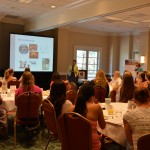Written by Katy Goshtasbi
Posted on: August 22, 2016
Share This
Just the other day I was forcing an issue with my husband. We were at a restaurant ordering lunch. Being a typical woman, I wanted him to “share” a burger and a salad with me instead of us both ordering a burger. It’s my attempt to be healthier and still eat what I love (a burger!). I kept suggesting it to my husband…. Over and over again. I wanted him to do what I wanted him to do. Free will was lost. So, he pushed back and we both got burgers.
Sound familiar? It should. Stuff like this happens so often.
What if I had just stopped and chosen to see the situation differently? Instead of “suggesting/forcing” my views on my husband, what if I had “allowed” the situation to be and allowed whatever was going to happen, to happen?
I guarantee you the end result would have been different.
Maybe we still would have ended up ordering burgers, but I wouldn’t have let myself down and expended so much negative energy pushing and shoving my will on my husband. I could have been happier in that moment.
Successful brands don’t force anything – on themselves or on others.
Anytime we force anything, we have active resistance around anything in our lives,. Then there is tension. Tension even shows up when we are “achieving” or “earning”.
Tension amps up our stress. Our stress amps up other peoples’ stress. Then people don’t want to be around us anymore, much less hire us, buy from us, promote us, date us. You name it. The game is over.
Instead, successful brands recognize that allowing life to happen sets everyone up for more success. Allowing life to happen, allows us to “be” with ease and grace. Ease and grace is the only way to let your brand shine and get us to stop, notice you and gravitate naturally to you.
What does this mean for you? Stop and consider:
- How often do you force your way and will in life? Next time, stop and have self-awareness: is it really working for you? Be honest with yourself.
- What if you stopped trying to “achieve” or “earn” and just “allowed”, instead?
- What would your life be like if you just “allowed” yourself and others to be? Where can you make subtle adjustments to allow more and force less?
Call or email me to discuss this strategy in your brand and life.

 Within organizations the one thing you can count on is change. Change is inevitable.
Within organizations the one thing you can count on is change. Change is inevitable. As the statistic goes, 78% of everything we buy is based on how we “feel” about it (product or service) and NOT the content. When I think back to any of my current purchases (for products or services), I’ve bought over 90% of them because I “liked” them.
As the statistic goes, 78% of everything we buy is based on how we “feel” about it (product or service) and NOT the content. When I think back to any of my current purchases (for products or services), I’ve bought over 90% of them because I “liked” them. I recently attended a concert by Adam Lambert. For those of you who need a refresher, Adam is the San Diego native who came in second place on American Idol, Season 8. Some would say looking back he really should have won and has had a more impactful career than the actual Season 8 winner.
I recently attended a concert by Adam Lambert. For those of you who need a refresher, Adam is the San Diego native who came in second place on American Idol, Season 8. Some would say looking back he really should have won and has had a more impactful career than the actual Season 8 winner.